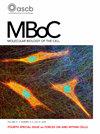RAD51 regulates eukaryotic chromatin motions in the absence of DNA damage.
IF 2.7
3区 生物学
Q3 CELL BIOLOGY
引用次数: 0
Abstract
In yeasts and higher eukaryotes, chromatin motions may be tuned to genomic functions, with transcriptional activation and the DNA damage response both leading to profound changes in chromatin dynamics. The RAD51 recombinase is a key mediator of chromatin mobility following DNA damage. As functions of RAD51 beyond DNA repair are being discovered, we asked if RAD51 modulates chromatin dynamics in the absence of DNA damage and found that inhibition or depletion of RAD51 alters chromatin motions in undamaged cells. Inhibition of RAD51 increased nucleosome clustering. Predictions from polymer models are that chromatin clusters reduce chain mobility and, indeed, we measured reduced motion of individual chromatin loci in cells treated with a RAD51 inhibitor. This effect was conserved in mammalian cells, yeasts, and plant cells. In contrast, RAD51 depletion or inhibition increased global chromatin motions at the microscale. The results uncover a role for RAD51 in regulating local and global chromatin dynamics independently from DNA damage and highlight the importance of considering different physical scales when studying chromatin dynamics.RAD51 在没有 DNA 损伤的情况下调节真核染色质的运动。
在酵母和高等真核生物中,染色质运动可能与基因组功能相适应,转录激活和DNA损伤反应都会导致染色质动态发生深刻变化。RAD51 重组酶是 DNA 损伤后染色质流动性的关键介质。我们发现,抑制或消耗 RAD51 会改变未受损细胞的染色质运动。抑制 RAD51 会增加核小体的聚集。根据高分子模型的预测,染色质集群会降低染色质链的流动性,事实上,我们在使用 RAD51 抑制剂处理的细胞中测量到单个染色质位点的运动性降低。这种效应在哺乳动物细胞、酵母菌和植物细胞中都是一致的。与此相反,RAD51 的耗竭或抑制增加了微观尺度上的全局染色质运动。这些结果揭示了RAD51在调节局部和全局染色质动力学中的作用,而与DNA损伤无关,并强调了在研究染色质动力学时考虑不同物理尺度的重要性。
本文章由计算机程序翻译,如有差异,请以英文原文为准。
求助全文
约1分钟内获得全文
求助全文
来源期刊

Molecular Biology of the Cell
生物-细胞生物学
CiteScore
6.00
自引率
6.10%
发文量
402
审稿时长
2 months
期刊介绍:
MBoC publishes research articles that present conceptual advances of broad interest and significance within all areas of cell, molecular, and developmental biology. We welcome manuscripts that describe advances with applications across topics including but not limited to: cell growth and division; nuclear and cytoskeletal processes; membrane trafficking and autophagy; organelle biology; quantitative cell biology; physical cell biology and mechanobiology; cell signaling; stem cell biology and development; cancer biology; cellular immunology and microbial pathogenesis; cellular neurobiology; prokaryotic cell biology; and cell biology of disease.
 求助内容:
求助内容: 应助结果提醒方式:
应助结果提醒方式:


